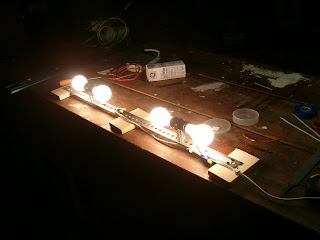Why, yes. Yes it is.
He told me the blade on his saw is an 8.25", and that's the biggest that will fit. I was walking up and down the aisle, not seeing any such size: the table saw blades being too big, and the circular saw blades being too small. I finally settled on an inexpensive 7.25" plywood blade meant for a circular saw, advertised as working on OSB and plastic as well. Lots of teeth - check. Cheap - check. There's a really cool one that looks like it could cut through a bass boat, but it's over $40 and I'm on a budget here.
My dad's table saw is a piece of junk. Now please understand that this is a guy who literally makes his own wooden replacement garage doors, with the inset panels and all that, and he rebuilds windows too. He doesn't have a problem with this saw - I do. It's got a 1/2" arbor and everything else in the world is 5/8", so he hand-centers the blade under the washer. No, really. Really. The rip fence needs to be shimmed with wood slivers for the lock-down lever to work, and it doesn't quite go parallel unless you measure it and tap it into position. The guy grew up helping my grandfather build houses, and I think that back in the day they had to cut wood with their fingernails - that must be it, because I don't think it's possible to cut a straight line with this saw.
That's what makes my father's table saw perfect for this job. If we live through it.
We masked up and I put some work gloves on. We adjusted the rip fence to approximately okay and I fed the piece in slow. The board has two fuzzy sides and no frame of reference, so I quickly got off track and started digging into the wood. I gave myself more room and just took the plastic off. This is probably what wrecked the blade. It stalled out completely and began to burn the plastic when I tried to cut one end off:
You can probably see how that cut is a little toasty. By this point the teeth on the blade were actually rounded off. You could throw it at a bowl of jello and it would bounce off. As a bonus, the air was indeed filled with scintillating death, a glass fiber death cloud that could have shut down air traffic downwind for 200 miles (current events reference!).
So what now? I'm 25% done turning this into a presentable piece of wood, and the future looks like an endless serious of broken table saw blades, burnt wood, melted epoxy, and a small Superfund cleanup. I'm thinking three things:
- Band saw! Someone else's band saw!
- Don't cut the plastic next time
- How on earth will I shape the neck, if simply cutting it is this difficult?












